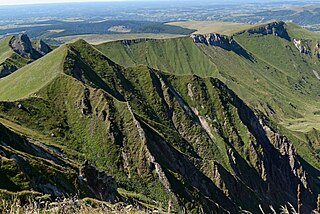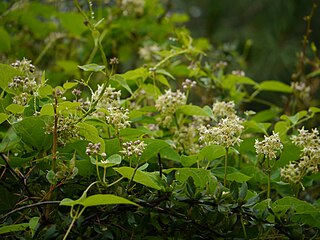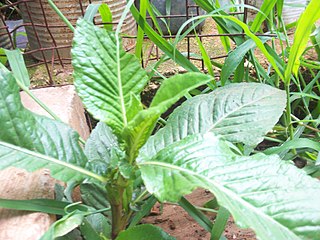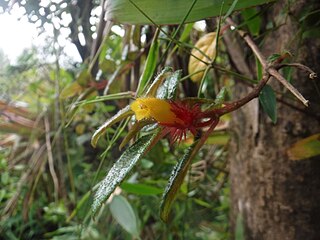
The Massif Central is a highland region in south-central France, consisting of mountains and plateaus. It covers about 15% of mainland France.

Ipomoea alba, sometimes called the tropical white morning-glory, moonflower or moon vine, is a species of night-blooming morning glory, native to tropical and subtropical regions of North and South America, from Argentina to northern Mexico, Arizona, Florida and the West Indies. Though formerly classified as genus Calonyction, species aculeatum, it is now properly assigned to genus Ipomoea, subgenus Quamoclit, section Calonyction.

Hypoxis decumbens is a species of plant in the Hypoxidaceae, considered by some authors to be included within the Liliaceae or Amaryllidaceae. The species is widespread across South America, Central America, Mexico, and the West Indies.

Quararibea turbinata, also known as the swizzlestick tree, is an aromatic plant native to such Caribbean locales as Antigua, Barbados, Dominica, Grenada, Guadeloupe, Hispaniola, Martinique, Montserrat, Netherlands Antilles, Puerto Rico, St. Kitts and Nevis, St. Lucia, Saint Vincent and the Grenadines and the Virgin Islands. It is generally described as a perennial tree or shrub and its common name comes from its use as a swizzle stick and its association with cocktails such as the Rum Swizzle.

Raphaël Liogier is a French sociologist and philosopher. He received his PhD in social sciences at the University Paul Cézanne (Aix-Marseille) in France, where he also received master's degrees in public law and in political science. Other degrees include a degree in philosophy from the University of Provence, and a Masters of Science (MSC) by research in philosophy from the University of Edinburgh in Scotland. Liogier has also studied social sciences as a visiting undergraduate at the University of California at Berkeley.

Ports de Tortosa-Beseit, also known as Ports de Beseit, or simply as Els Ports or Lo Port by locals, is a limestone mountain massif located at the north-eastern end of the Sistema Ibérico, a complex system of mountain ranges and massifs in the centre of the Iberian Peninsula. Its highest point is Mont Caro, 1,441 m. Rivers such as the Matarranya and the Cenia have their source in these mountains.

Oplonia spinosa, the pricklybush, is a species of plant in the family Acanthaceae, endemic to several Caribbean islands. It is a spiny shrub ranging in height from dwarf to 3 meters, with curved spines 4–12 mm long, and leaves variable in size and shape.
Dendropanax laurifolius is a tree in the family Araliaceae. It is endemic to Puerto Rico, and is found in moist regions of forests at middle or high elevations.
Randia portoricensis, known commonly as the Puerto Rico indigoberry, is a species of shrub in the family Rubiaceae. It is endemic to Puerto Rico, and is found in thickets and semi-dry forests.
Myrcia margarettae is a species of shrub in the family Myrtaceae. It is endemic to Puerto Rico. It reaches a height of 4–5 metres.
Matelea sintenisii, known commonly as the Sintenis' milkvine, is a species of plant in the family Apocynaceae. It is endemic to Puerto Rico, and is found in forests and moist districts.
Matelea variifolia, synonyms including Matelea borinquensis, known commonly as the San Lorenzo milkvine, is a species of plant in the family Apocynaceae. It is a forest plant, endemic to Puerto Rico, and is found in Cerro Pelucho, San Lorenzo.

Vincetoxicum auriculatum, synonym Cynanchum auriculatum, is a species of climbing vine. Its Chinese name is niu pi xiao [ 牛皮消 ]. V. auriculatum flowers between June and August; fruiting from August all the way to December.
Henri Alain Liogier, also known as Brother Alain was a French botanist, educator, and member of the clergy based out of Texas, United States. Liogier is responsible for over 100 scientific journal articles and over 30 books devoted to the study of botany. He published the quintessential work on the flora of Cuba, Hispaniola and Puerto Rico, and these works are the foundation of botanical science for the Caribbean. During his life's work, he discovered over 300 species of plants all of which can be found at the New York Botanical Garden where he also served as a research associate. He was a founding member of the Academy of Science and first scientific director of the National Botanical Garden in the Dominican Republic. Dr. Liogier was recipient of the John Simon Guggenheim Fellowship for Studies in Plant Science. He was also the director of the Botanic Garden at the University of Puerto Rico.

Iresine angustifolia is a plant in the genus Iresine of the family Amaranthaceae.

Pasta frola, pasta frolla, is a type of sweet tart common to Italy, Argentina, Paraguay, Uruguay, Egypt and Greece. It is a covered, jam-filled shortcrust pastry dish principally made from flour, sugar and egg. Common fillings include quince cheese, dulce de batata, dulce de leche, guava, or strawberry jam. The covering of the tart is a thin-striped lattice which displays the filling beneath in rhomboidal or square sections. Pastafrola is most usually oven-baked in a circular shape. Most of the Greek versions of this dish are filled with sweet jam: it is considered a morning dessert.

Picardaea is a genus of plant in the family Rubiaceae. Picardaea haitiensis is the only member of this genus and endemic to the island of Hispaniola in the Caribbean. It is listed as endangered in the red list of the Dominican Republic but is not currently assessed by the IUCN.

Rhytidophyllum leucomallon is a species of plant in the family Gesneriaceae, endemic to Hispaniola. According to Liogier it can be found in the Dominican Republic and in Haiti.

Columnea domingensis is a species of plant in the family Gesneriaceae. According to Liogier it can be found in the Dominican Republic and in Haiti.
Myrciaria borinquena is a species of plant in the family Myrtaceae and is endemic to the forests of Puerto Rico. It is a small tree that produces round fruit around 25mm in diameter.













